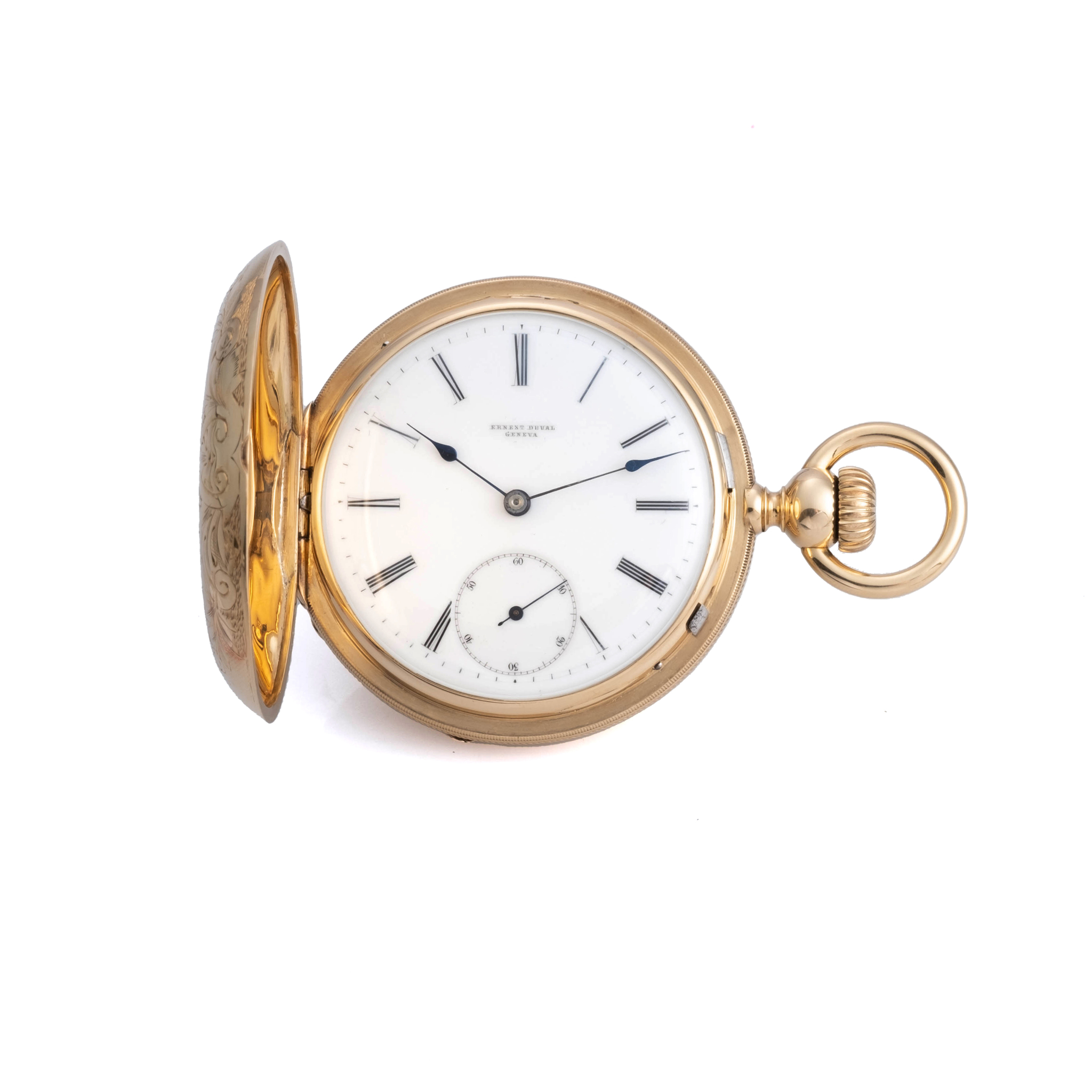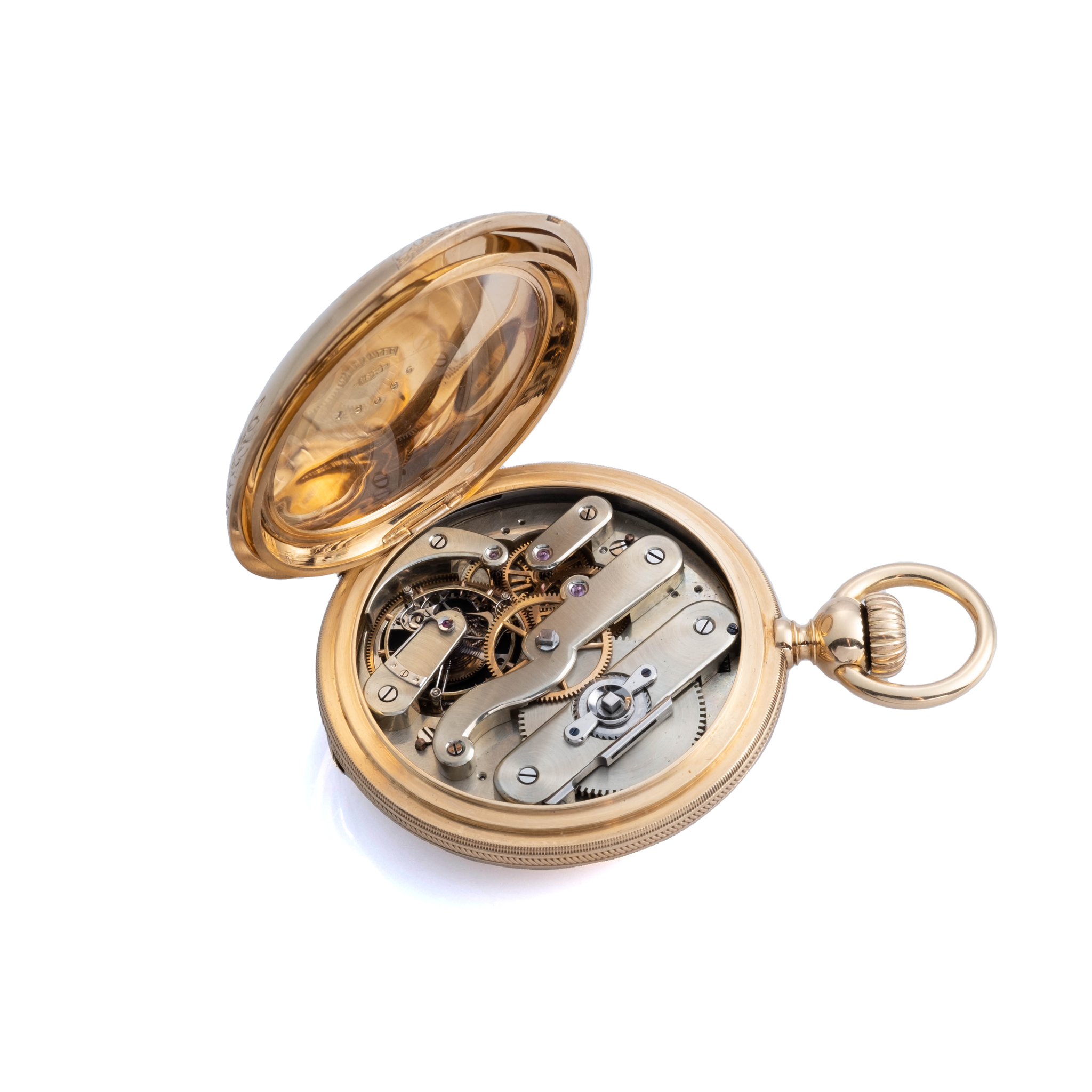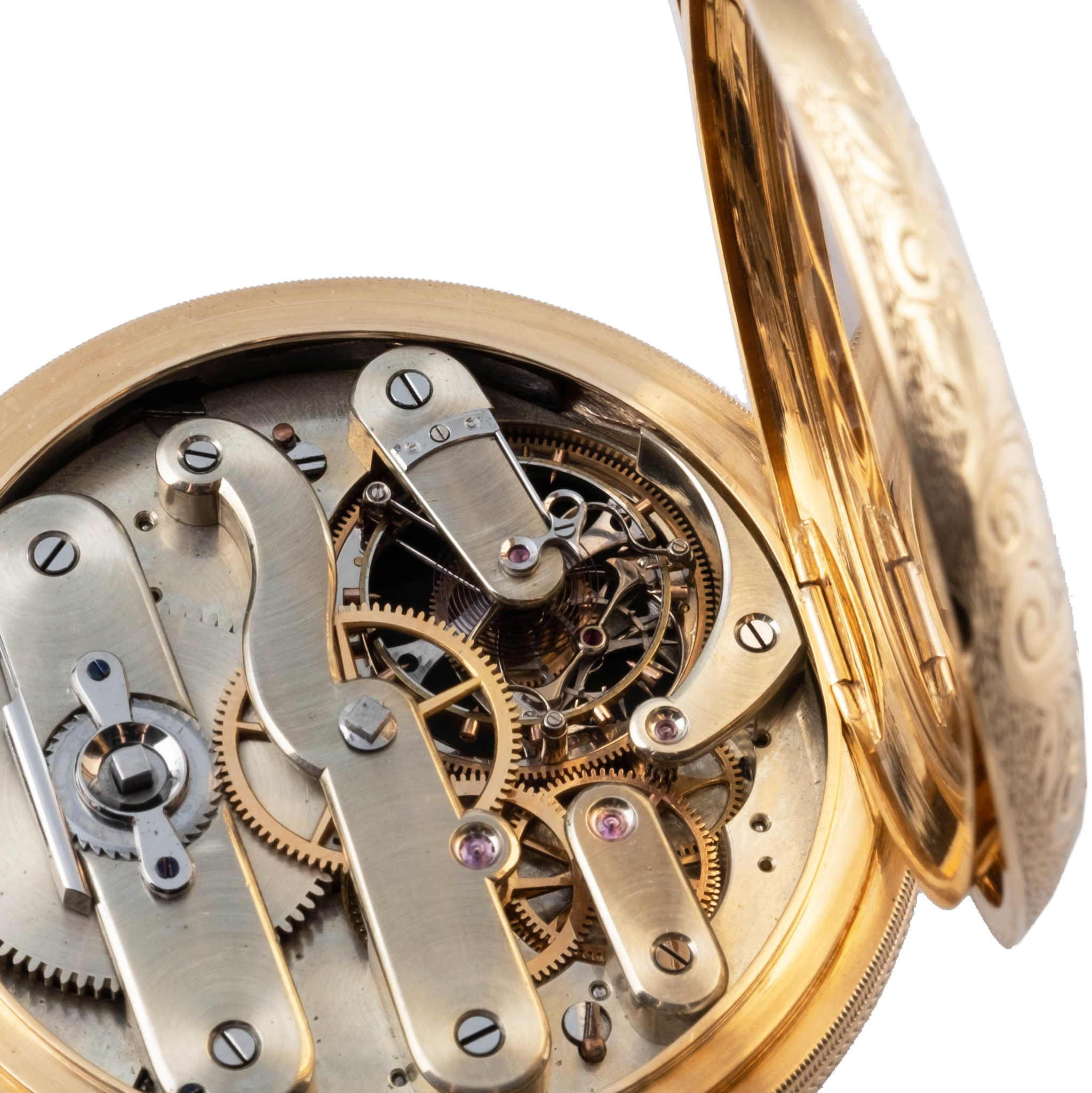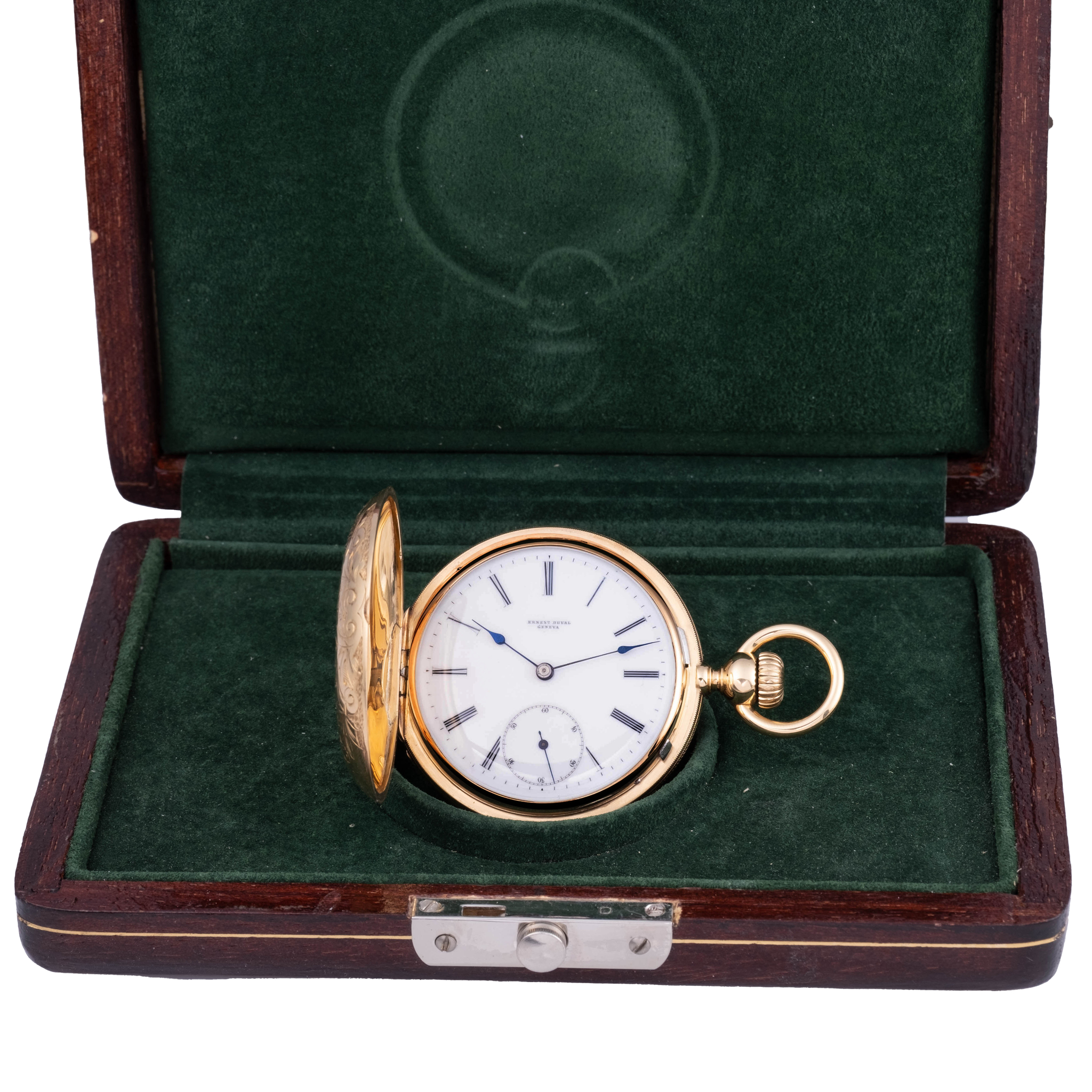Hong Kong, May 29, 2022
LOT 389
Ernest Duval
Pocket chronometer, one-minute tourbillon regulator, duplex escapement; 18K yellow gold
HKD 144,000 - 190,000
EUR 17,200 - 22,900 / CHF 18,000 - 24,000 / USD 18,200 - 24,200
18K yellow gold, hunting-case, keyless-winding, round-shaped, pocket chronometer, with subsidiary seconds at 6 and a one-minute tourbillon regulator.
Cover and case-back guilloché (engine-turned) and engraved in taille-douce (fine cut) with foliage; on the cover, in the centre, an escutcheon; glazed gold cuvette (dome).
White enamel dial with radial Roman numerals; blued steel “Spade” hands.
Movement 19’’’ ½, nickel-plated, going barrel, gold train of wheels, one-minute tourbillon regulator with duplex escapement, cut bimetallic compensated balance with gold poising screws and free-sprung blued steel flat hairspring, polished steel pare-chute.
Cover and case-back guilloché (engine-turned) and engraved in taille-douce (fine cut) with foliage; on the cover, in the centre, an escutcheon; glazed gold cuvette (dome).
White enamel dial with radial Roman numerals; blued steel “Spade” hands.
Movement 19’’’ ½, nickel-plated, going barrel, gold train of wheels, one-minute tourbillon regulator with duplex escapement, cut bimetallic compensated balance with gold poising screws and free-sprung blued steel flat hairspring, polished steel pare-chute.
| Grading System | |
|---|---|
Grade: AAA |
Excellent |
Case: 3-8 |
Good Slightly scratched |
Movement: 3* |
Good Overhaul recommended, at buyer's expense |
Dial: 3-01 |
Good HANDS Original |
Brand Ernest Duval, Geneva
Year circa 1870
Movement No. unnumbered
Case No. 18 086 (by “B.W.C.Co.”, Brooklynn Watch Case Company, New York)
Material 18K yellow gold
Diameter 54 mm.
Caliber 19’’’ ½, duplex escapement, one-minute tourbillon regulator
Weight 128.3 gr. (approx.)
Signature dial
Accessories modern fitted box
Notes
Duval, Ernest
Ernest Duval, watchmaker, was active in Geneva in the last third of the 19th century and in the early 20th century. His watches were imported in the United States of America by Edmond E. Robert, New York, in the early 20th century.
Bibliography
Pritchard, Kathleen H., Swiss Timepiece Makers, p. D-113.
Pritchard, Kathleen H., Swiss Timepiece Makers, p. D-113.
--
The ebauche of this watch is most probably of Neuchâtel origin. A pocket chronometer signed Girard Perregaux, with a pivoted detent escapement, so-called à bascule, is built with exactly the same blank.
The combination of a one-minute tourbillon and a duplex escapement – more commonly found in watches made for the Chinese market – is highly unusual.
In fact, only one other pocket chronometer with tourbillon and duplex escapement is known (two-minute rotation). It was especially made by Emile Buffat from Sechey (Vallée de Joux) for the Universal exhibition in Paris in 1867 and was dedicated to Napoleon III (1808-1873), Emperor of the French (1852-1870). Already in the Universal exhibition of Paris in 1855, Buffat has shown a tourbillon with dead seconds who received a Medal of 2nd class.
The Buffat 1867’s tourbillon is illustrated by Reinhard Meis in “Das Tourbillon. Faszination der Uhrentechnik” (1986, pp. 119, 344, ill. 67-68) and in the “Horological Journal” of March 1980 (vol. 122, No. 9, pp. 28 and 31). Part of the collection of Captain Peter Belin and Ferdinand Lammot Belin, Washington DC (Inv. No. 49), it was auctioned three times:
· Sotheby’s, London, auction, November 29, 1979, “The Belin Collection”, lot 176.
· Christie’s, London, auction, June 9, 1999, lot 343.
· Sotheby’s, Geneva, auction, November 12, 2020, lot 602, sold for the mount of CHF 60 480.
--
--
The Brooklynn Watch Case Company, New York
The primary mark used by the Brooklyn Watch Case Company was the initialised company name as “B.W.C.Co.” Some early cases are marked “B.W.C.F.” on the inner cuvette (dome), denoting “Brooklyn Watch Case Factory”. Later cases can be identified by the iconic “dog bone” shape with “B.W.C.Co.” inside. Reports in original trade magazines indicate some individuals fraudulently marked gold-filled cases to appear to be solid gold cases from the Brooklyn factory. For this reason, caution should be exercised when encountering a suspicious mark. The Fahys Watch Case Company produced cases under the Brooklyn trade names, and some may be marked “F.W.C.Co.” or “F.W.Co.”, typically seen circa 1900-1910. Some cases are marked “A”, “1”, or “A1” under the primary mark or on the cuvette (dome), possibly as a grading indicator. The Brooklyn Watch Case Company produced “private label” cases. Prominent firms that purchased specially marked cases include Wheeler, Parsons & Co. and E. Howard & Co. Sold to Fahys Watch Case Co. in January 1873, Fahys continued to utilise the trademarks for marketing solid gold cases.
The primary mark used by the Brooklyn Watch Case Company was the initialised company name as “B.W.C.Co.” Some early cases are marked “B.W.C.F.” on the inner cuvette (dome), denoting “Brooklyn Watch Case Factory”. Later cases can be identified by the iconic “dog bone” shape with “B.W.C.Co.” inside. Reports in original trade magazines indicate some individuals fraudulently marked gold-filled cases to appear to be solid gold cases from the Brooklyn factory. For this reason, caution should be exercised when encountering a suspicious mark. The Fahys Watch Case Company produced cases under the Brooklyn trade names, and some may be marked “F.W.C.Co.” or “F.W.Co.”, typically seen circa 1900-1910. Some cases are marked “A”, “1”, or “A1” under the primary mark or on the cuvette (dome), possibly as a grading indicator. The Brooklyn Watch Case Company produced “private label” cases. Prominent firms that purchased specially marked cases include Wheeler, Parsons & Co. and E. Howard & Co. Sold to Fahys Watch Case Co. in January 1873, Fahys continued to utilise the trademarks for marketing solid gold cases.
Provenance
Christie’s, Geneva, auction, May 14, 2007, lot 266, sold for the amount of CHF 28 800.-






